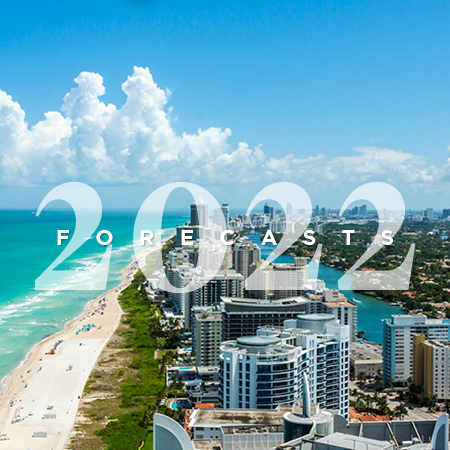Pandemic restrictions and geopolitical worries did not hold back Asia Pacific real estate investors in 2021, which should mean that any further improvement will be greeted by more optimism.
The region’s real estate markets were remarkably resilient in 2021, with an estimated 30% rise in volumes compared with 2020, a record bounce back. Whether there are similar levels of activity ahead is dependent on how the pandemic develops and the response of policy makers.
Omicron has scared governments worldwide into clamping down on travel and trade, however markets have been less concerned about a variant that appears to cause milder symptoms. Higher vaccination rates (Asia is 50% fully vaccinated but some nations have more than 70% double-jabbed) and better treatments should encourage more countries to relax travel restrictions and ease social distancing.
There are reasons to be positive: Asia Pacific economies recovered lost GDP growth this year and will grow further in 2022, led by India (8.8%) and China (8.2%), although Hong Kong and Singapore forecasts (6.5% and 6.4% respectively) are also bullish. The weight of capital allocated to the region by private equity real estate funds suggests active deal making ahead. While a relatively benign inflationary environment suggests a modest interest rate rise.
Of course, there are risks, least of all around geopolitical tensions. The region’s economies are more integrated following recently negotiated trade agreements, and any tariffs changes or import restrictions will create a widespread negative impact.
If the same trends observed in 2021 persist then cross-border investors will remain focused on the larger, more liquid markets of Korea, Australia and Japan, while China’s investment levels, although high, will be driven by domestic buyers. For the international investor, Asia’s largest economy is beset by uncertainties over zero-Covid policies, debt bubbles and shifting government priorities. Hong Kong increasingly moves in sync with the Mainland. Singapore’s stability, however, should maintain its allure.
Industrial & logistics will continue to be the favoured sector, despite supply chain disruption. The sector has come to encompass a broader range of uses including manufacturing and storage, R&D, data centers, high-tech manufacturing, last mile delivery/urban logistics and temperature-controlled facilities.
Life sciences, flexible office space, senior housing and multifamily housing will remain popular. The prospects for the traditional offices, high end or tourism-related retail and hospitality are less certain. The pandemic, combined with advances in technology and changing habits, is causing investors to rethink strategies. Regional retail and hospitality rely heavily on cross-border tourism, particularly from mainland China, and without a resumption of travel it is difficult to see a way forward.
Older offices in core business districts face challenges from technology-enabled hybrid working. Meanwhile, younger generations expect a different experience from seasoned staff, with a greater emphasis on wellbeing, collaborative spaces and virtual communications.
Sustainable buildings are attracting investors, developers and occupiers, among a rising tide of regulation and a growing awareness of ESG. Net zero pathways and low energy buildings will become a priority over the coming years. Mounting evidence of a ‘green premium’ suggests a tangible shift is underway and investors don’t want to be left behind.
2022 Asia Pacific Investment Tips
- First tier city logistics, core offices and key business parks in China
- Prime offices in India and Japan
- Logistics and prime offices in Singapore
- Multifamily in Japan
- Satellite city logistics and core retail in China
- Seoul prime office and Pangyo offices
- Prime logistics and mixed logistics (dry & cold storage) in South Korea
- Office and retail in Seongsu, a growing district in Seoul
- Multifamily conversions in China
- Developed but vacant or partially-leased offices in India
- Conservation of shops to houses and residential development in Singapore
- Urban retail, high street retail and high vacancy offices in Japan
- Re-modelling in prime locations in South Korea
- Major retail districts in South Korea
- Debt and distressed residential in China
- Hotels in Singapore and Japan and South Korea
- Branded residences in Japan
- Office & logistics developments in South Korea
- Retail for residential conversion in South Korea
- Life sciences and cold storage in China
- Data centres; life sciences and senior living in India
- Elderly care facilities in Singapore and Japan
- Student housing in Japan and India
- Data centers, residential officetel (live/work units) in South Korea
Key countries in focus
China: Sectors that continue to receive government support will see a growing investor appetite, namely the multifamily sector as well as logistics, cold storage, life sciences, and data centres.
India: The interplay of global capital in local Indian real estate has never been as apparent and is poised to take root in this decade.
Singapore: Although Singapore’s pandemic measures have loosened, further restrictions remain an ever-present possibility.
Japan: Although the pandemic continued into 2021, the second half of the year showed significant progress.
South Korea: The OECD is forecasting GDP growth of 4.0% in 2021 and 3.0% in 2022. This should help underpin occupier demand. Uncertainty is expected in the run up to the Presidential election in March.
China
Sectors that continue to receive government support will see a growing investor appetite, namely the multifamily sector as well as logistics, cold storage, life sciences, and data centres.
A recovering economy in the commercial sectors has boosted aggregate demand, though regulatory headwinds and the ongoing financial de-risking may restrain corporate and consumer demand.
Debt concerns will weigh on China’s property market in 2022 with several repayment events likely in the first quarter. Tighter financing has forced developers to restructure asset ownership and rein in new investment, while distressed asset sales are likely to increase.
International investors have been less active given ongoing travel restrictions and market concerns, although those with an established platform are still able to execute deals and have focused on platforms and portfolios. Self-use purchases have accounted for an increasing share of domestic deals in the commercial sector as firms establish new headquarter spaces.
2022 China Tips
Core
- First tier city logistics
- Core offices
- Key business parks
Core plus
- Satellite city logistics
- Core retail
Value-Add
- Conversion to multifamily
Opportunistic
- Debt
- Distressed residential
Alternative
- Life sciences
- Cold chain
India
The interplay of global capital in local Indian real estate has never been as apparent and is poised to take root in this decade.
Despite a real estate liquidity crises in October 2018 and two severe waves of a pandemic, there is increasing interest and participation from offshore investors in India.
In recent years there have been unprecedented regulatory and policy changes. The residential market, which bottomed out pre-pandemic, is now leading the revival across micro-markets. At the close of the last decade came two of the largest transactions in the office and retail space and the first ever investment into life sciences.
There has also been a broadening of the investor base, with the arrival of new Canadian, European, and Asian investors in Indian real estate. This coupled with the growing exposure across newer asset classes – like office, stressed loans, impact housing, warehousing and data centres – will have a far reaching effect that may fuel a paradigm shift in Indian real estate.
Commercial office, affordable housing, loan book purchases, data centres, warehousing, life sciences, and private credit are the key areas of interest for 2022.
The next ten years are likely to be dominated by the life sciences industry. This industry is at an inflection point, with growth drivers already in place. India has the potential to create a demand for approximately 96 million sq. ft. of life sciences research and development real estate from 2021 till 2030, according to Savills. This willprovide institutional investors with ample opportunity to increase allocations to the sector, especially around development. The life sciences research and development real estate universe in India holds the potential to attract private equityinstitutional investment amounting to $18 billion (INR 1,350 billion).
2022 India Tips
Core / Core Plus
- Prime ready office
Value-Add
- Built but unleased or partially leased office
Built To Core
- Ground up development / under construction office
Credit
- Residential Structured Credit
Alternative
- Data centers
- Student housing
- Life sciences
- Senior living
Singapore
Although Singapore’s pandemic measures have loosened, further restrictions remain an ever-present possibility.
This has caused difficulty for the lower grade CBD office and overall Downtown & Orchard Road retail markets, given the uncertainty surrounding when workers and shoppers will return . Only the top CBD offices are holding up as their modern designs appeal to tech companies– arguably the only major industry that can afford to pay high rents.
Ample liquidity in the system remains, especially among developers, institutional investors and high net-worth individuals. These will continue to look to deploy capital. Although an interest rate rise is expected, the pressure to commit capital is expected to prevail.
The brightest prospects in terms of income stability are in the industrial/logistics sector. The need to de-risk supply chains given recent disruptions and the possibility of inflation has driven demand for warehousing space. The popularity of e-commerce has had the same effect.
On the development-for-profit front, 2022 should be another year when the private residential market attract the most capital. The strong take-up of new launches is resulting in developers’ inventories falling rapidly, and by mid-2022 they could reach dangerously low levels.
Developers’ need to replenish land banks is already pressing urgent because sales remain elevated. The opportunity for foreign capital into residential development is ripe so we expect new entrants. Most are expected to join forces with local developers.
The pandemic has battered the hospitality sector so could offer an opportunity during a recovery if a long-term global solution can be found that significantly increases travel.
If new and more fatal variants emerge in short succession, this could test society’s patience, and undermine future growth prospects. Also, any failure to develop a long-term plan towards living with the virus will lead to a confidence loss on numerous fronts.
2022 Singapore Tips
Core and Core-plus
- Logistics
- Prime offices
Value-Add
- Conservation shophouses
- Residential development
Opportunistic
- Hotels
- Serviced apartments
Alternative
- Elderly care facilities
Japan
Although the pandemic continued into 2021, the second half of the year showed significant progress.
In Japan, COVID-19 cases plummeted, and almost 80% of the country was fully vaccinated. Furthermore, corporate profits of many large firms were at all-time highs during Q2/2021. The recovery the country has experienced, and the stability going forward, should further solidify Japan’s appeal as a destination for investors who value its well-regulated and highly liquid markets.
Some distressed selling has been in evidence while the elevated unit prices of J-REITs has allowed them to raise equity for acquisitions. The hunt for yield has forced many investors to broaden their investment focus to more niche asset classes. Urban retail has continued to lag even though high street retail remains sought after and investors will be hoping for a clear turnaround in 2022.
Risks remains as sluggish growth could result in a mild stagflation. Rising interest rates remain a possibility and at some point, this could pose problems for the country’s notoriously high levels of government debt. Regional tensions also have the potential to disrupt the free flow of trade in a region which has become increasingly economically integrated. Further rounds of travel restrictions and social distancing measures remain a possibility if new variants emerge.
2022 Japan Tips
Core and Core-plus
- Multifamily
- Prime offices
Value-Add
- Urban retail
- High street retail
- High vacancy offices
Opportunistic
- Hotels
- Branded residences
Alternative
- Student housing
- Elderly care facilities
South Korea
There were two rate hikes in 2021 in order to hold off inflation, and further rises are expected, possibly taking the base rate to 1.5%. Meanwhile, the OECD is forecasting GDP growth of 4.0% in 2021 and 3.0% in 2022. This should help underpin occupier demand. Uncertainty is expected in the run up to the Presidential election in March.
Offices remain ever popular given strong demand and declining new supply. A greater focus on amenity from tenants has given rise to value-add opportunities, while sustainability and ESG has thrown the spotlight on safe work environments, reduced carbon footprints and greater digitalization.
Among investors we note an increasing number of share deals, and activity dominated by major asset managers faced with a limited number of opportunities. We expect to see more REITs established by conglomerates as a means of offloading real estate holdings while maintaining control of the underlying assets.
2022 South Korea Tips
Core
- Seoul prime office & Pangyo office
- Prime logistics
Core plus
- Mixed logistics (dry & cold storage)
- Seongsu (growing area for both office & retail in Seoul) office & retail
Value-Add
- Re-modelling in prime locations
- Major retail districts
Opportunistic
- Office & logistics developments
- Hotel & retail for residential conversion
Alternative
- Data centers
- Residential officetel (live/work units)




